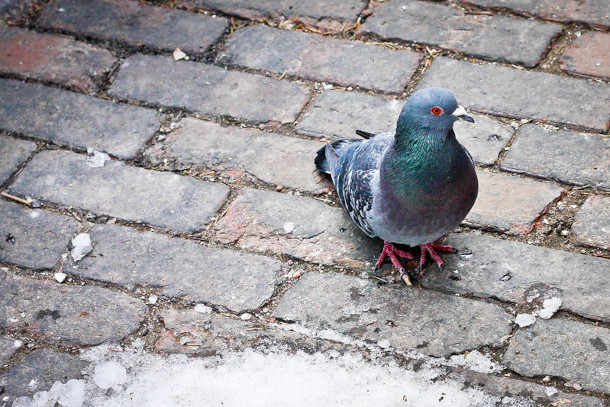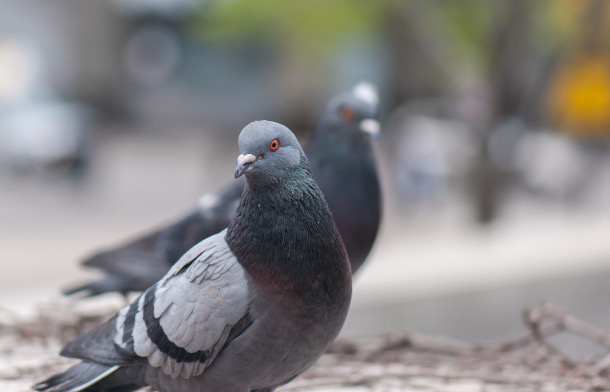BirdNote®: Pigeons Love Cities - But We Loved Them First
Air Date: Week of May 19, 2023

The first recorded evidence of pigeons flocking to cities began in Mesopotamia, 7000 years ago. (Photo: Suzanne Schroeter, CC)
Pigeons are everywhere in our cities, and even though some may seem them as winged rats, pigeons and people have a long-standing bond. Ashley Ahearn reports in this BirdNote®.
Transcript
DOERING: In a moment we’ll talk about the chickens taking over some backyards but first, Ashley Ahearn has this BirdNote about how another flocking species became our neighbors.
BirdNote®
Pigeons Love Cities - But We Loved Them First
[Rock Pigeon flapping, then calling, https://macaulaylibrary.org/asset/167946961#_ga=2.4163696.1502895711.156..., 0.02-.05]
Pigeons are everywhere in our cities. But how did they get there? Short answer: we invited them.
It started in the earliest cities of Mesopotamia, 7000 years ago. Humans cultivated grain; wild pigeons came to forage. Mesopotamians encouraged pigeons to nest in man-made shelters… But they had some ulterior motives. Pigeons’ fat chicks — or squabs — were a delicacy, and adult pigeons were sacrificed to the gods.

Historically, humans have kept pigeons for many reasons, from messengers to meals. (Photo: Brad Hagan, CC)
[ Rock Pigeon calls, https://macaulaylibrary.org/asset/3891#_ga=2.25012474.1502895711.1563575..., 0.04-.-08]
Early civilizations also discovered pigeons’ brilliant homing ability. The birds could point wandering ships homeward and speedily carry messages across large distances.
Pigeon racing — which is still a sport today — has ancient roots, too.
Charles Darwin bred pigeons, and pondered their inherited traits.
[Rock Pigeon flapping, https://macaulaylibrary.org/asset/167023011#_ga=2.126271821.1502895711.1..., 0.03-.05]
So until recently in our shared history, pigeons did all the work. Serving as meat, sacrifices, navigators, messengers, racers, hobby supplies and science experiments.
And they took readily to cities because, long before they met up with people, pigeons nested on cliffs, making them perfectly suited to building their nests on skyscrapers or tucked into the eaves of urban apartment complexes.
Though some might see them as winged rats in today’s cities, pigeons and people have a long-standing bond. Especially in our urban environment.
[Rock Pigeon calls, https://macaulaylibrary.org/asset/3891#_ga=2.25012474.1502895711.1563575..., 0.04-.-08]
###
Written by Bob Sundstrom
Producer: John Kessler
Executive Producer: Sallie Bodie
Editor: Ashley Ahearn
Associate Producer: Ellen Blackstone
Assistant Producer: Mark Bramhill
Bird sounds provided by The Macaulay Library of Natural Sounds at the Cornell Lab of Ornithology, Ithaca, New York. ML167946961 recorded by P Marvin 0:05- 0:25. ML3891 by J Kimball 0:35.
ML167023011 by P Marvin 0:56 and as ambient throughout
BirdNote’s theme was composed and played by Nancy Rumbel and John Kessler.
© 2020 BirdNote February 2020 Narrator: Ashley Ahearn
ID# ROPI-06-2020-02-21 ROPI-06
Primary source: https://www.livescience.com/63923-why-cities-have-so-many-pigeons.html
Also: http://mentalfloss.com/article/54844/history-pigeon
https://www.allaboutbirds.org/guide/rock_pigeon/lifehistory
https://www.birdnote.org/show/pigeons-love-cities-we-loved-them-first
CURWOOD: For pictures, flock on over to the Living on Earth website, LOE dot org
Links
Living on Earth wants to hear from you!
Living on Earth
62 Calef Highway, Suite 212
Lee, NH 03861
Telephone: 617-287-4121
E-mail: comments@loe.org
Newsletter [Click here]
Donate to Living on Earth!
Living on Earth is an independent media program and relies entirely on contributions from listeners and institutions supporting public service. Please donate now to preserve an independent environmental voice.
NewsletterLiving on Earth offers a weekly delivery of the show's rundown to your mailbox. Sign up for our newsletter today!
 Sailors For The Sea: Be the change you want to sea.
Sailors For The Sea: Be the change you want to sea.
 The Grantham Foundation for the Protection of the Environment: Committed to protecting and improving the health of the global environment.
The Grantham Foundation for the Protection of the Environment: Committed to protecting and improving the health of the global environment.
 Contribute to Living on Earth and receive, as our gift to you, an archival print of one of Mark Seth Lender's extraordinary wildlife photographs. Follow the link to see Mark's current collection of photographs.
Contribute to Living on Earth and receive, as our gift to you, an archival print of one of Mark Seth Lender's extraordinary wildlife photographs. Follow the link to see Mark's current collection of photographs.
 Buy a signed copy of Mark Seth Lender's book Smeagull the Seagull & support Living on Earth
Buy a signed copy of Mark Seth Lender's book Smeagull the Seagull & support Living on Earth

